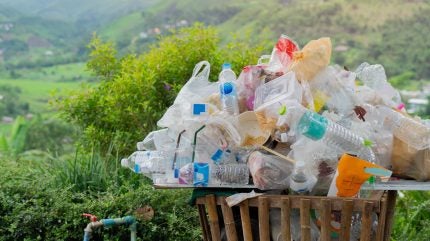UC Berkeley develops catalytic process to advance circular economy


Researchers at the University of California (UC), Berkeley, Develop Groundbreaking Chemical Process for Plastic Recycling

Researchers at the University of California (UC), Berkeley, have developed a groundbreaking chemical process that can transform the most prevalent forms of plastic waste into reusable hydrocarbon materials.
Advancing the Circular Economy for Plastics
This innovation could significantly advance the circular economy for plastics by enabling the recycling of polyethylene (PE) and polypropylene (PP), the primary components of single-use plastic bags and hard plastics.
The catalytic process could revolutionize the way the industry handles plastic waste.
PE and PP are ubiquitous in everyday items such as shopping bags, detergent bottles, and various containers, making them a significant contributor to the global waste problem.
The technology offers a promising solution to reduce reliance on fossil fuels for new plastic production by converting plastic waste back into the monomers required to create polymers.
While polyethylene terephthalate (PET) plastics, commonly used in water bottles, were designed for recycling, polyolefins such as PE and PP represent a much larger portion of plastic waste and have lacked an efficient recycling method until now.
Significance for the Sustainable Development Goals (SDGs)
- SDG 12: Responsible Consumption and Production
- SDG 14: Life Below Water
- SDG 15: Life on Land
UC Berkeley professor in chemistry John Hartwig said: “We have an enormous amount of polyethylene and polypropylene in everyday objects, from lunch bags to laundry soap bottles to milk jugs – so much of what’s around us is made of these polyolefins.
“What we can now do, in principle, is take those objects and bring them back to the starting monomer by chemical reactions we’ve devised that cleave the typically stable carbon-carbon bonds. By doing so, we’ve come closer than anyone to give the same kind of circularity to polyethylene and polypropylene that you have for polyesters in water bottles.”
Collaborative Effort and Publication
The collaborative effort included contributions from graduate student Richard J ‘RJ’ Conk and UC Berkeley Graduate School professor and chemical engineer Alexis Bell.
The team’s findings were published on 29 August 2024 in the journal Science.
SDGs, Targets, and Indicators
1. Which SDGs are addressed or connected to the issues highlighted in the article?
- SDG 12: Responsible Consumption and Production
- SDG 13: Climate Action
- SDG 14: Life Below Water
- SDG 15: Life on Land
2. What specific targets under those SDGs can be identified based on the article’s content?
- SDG 12.5: By 2030, substantially reduce waste generation through prevention, reduction, recycling, and reuse.
- SDG 13.3: Improve education, awareness-raising, and human and institutional capacity on climate change mitigation, adaptation, impact reduction, and early warning.
- SDG 14.1: By 2025, prevent and significantly reduce marine pollution of all kinds, particularly from land-based activities, including plastic debris and nutrient pollution.
- SDG 15.5: Take urgent and significant action to reduce the degradation of natural habitats, halt the loss of biodiversity, and protect and prevent the extinction of threatened species.
3. Are there any indicators mentioned or implied in the article that can be used to measure progress towards the identified targets?
The article does not explicitly mention any indicators to measure progress towards the identified targets. However, potential indicators could include:
- Amount of plastic waste recycled
- Reduction in the use of fossil fuels for plastic production
- Reduction in the presence of polyethylene and polypropylene in marine environments
- Improvement in the conservation status of species affected by plastic pollution
SDGs, Targets, and Indicators
| SDGs | Targets | Indicators |
|---|---|---|
| SDG 12: Responsible Consumption and Production | SDG 12.5: By 2030, substantially reduce waste generation through prevention, reduction, recycling, and reuse. | Amount of plastic waste recycled |
| SDG 13: Climate Action | SDG 13.3: Improve education, awareness-raising, and human and institutional capacity on climate change mitigation, adaptation, impact reduction, and early warning. | Reduction in the use of fossil fuels for plastic production |
| SDG 14: Life Below Water | SDG 14.1: By 2025, prevent and significantly reduce marine pollution of all kinds, particularly from land-based activities, including plastic debris and nutrient pollution. | Reduction in the presence of polyethylene and polypropylene in marine environments |
| SDG 15: Life on Land | SDG 15.5: Take urgent and significant action to reduce the degradation of natural habitats, halt the loss of biodiversity, and protect and prevent the extinction of threatened species. | Improvement in the conservation status of species affected by plastic pollution |
Source: packaging-gateway.com








